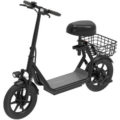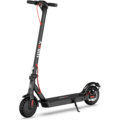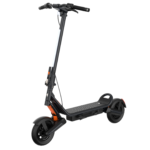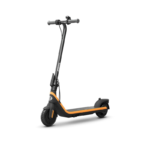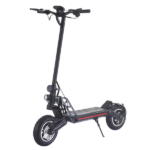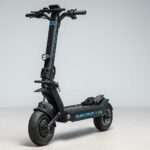- Home
- Scooters
- Electric Scooters
- Hiboy S2 Lite
Hiboy S2 Lite
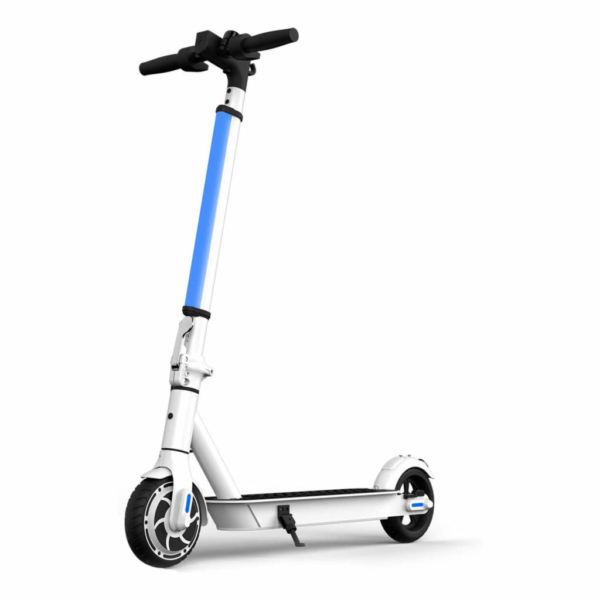

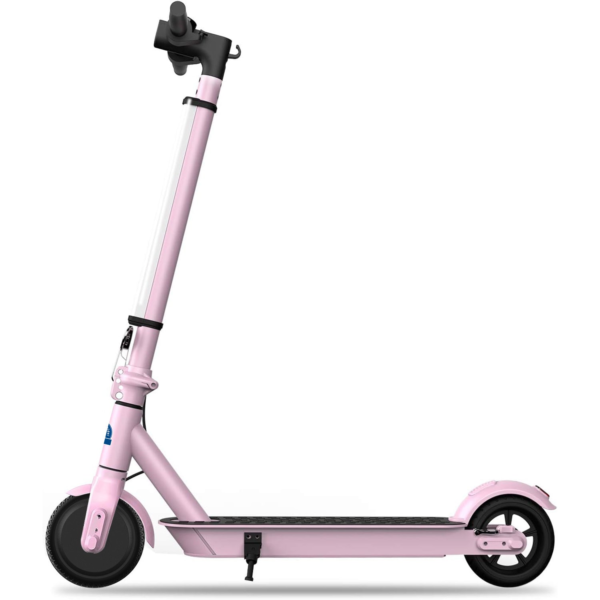

- Battery Range: 10.6 mi (17 km)
- Top Speed: 13 mph (21 km/h)
- Motor Power: 250 W nominal
- Weight Capacity: 180 lb (82 kg)
- Charging Time: ~4–5 h
- Scooter Weight: 26.5 lb (12.0 kg)
PROS
- Very light and easy to carry
- Fast, simple folding latch
- Maintenance-free honeycomb tires
- Beginner-friendly throttle mapping
- Low ownership costs
CONS
- Shorter range vs larger models
- Solid tires ride firm on rough patches
- Limited hill performance
- Front e-brake + foot brake only
Table of contents
- Introduction: Why the Hiboy S2 Lite Stands Out
- Who the Hiboy S2 Lite Is Best For
- Design Philosophy: Small, Simple, and Purpose-Built
- Ride Feel: Calm, Predictable, and Confidence-Building
- Practical Performance: Speed, Modes, and Everyday Use
- Battery, Range, and Charging Rhythm
- Braking and Control: What to Expect
- Lighting and Visibility
- Portability: Where the S2 Lite Excels
- Comfort and Ergonomics
- Maintenance Made Simple
- Weather and Surface Conditions
- Security and Charging Habits
- Day-One Setup Checklist
- Everyday Scenarios: How It Performs
- Battery Care for Long Life
- Tires, Flats, and Ride Quality
- Accessibility and Learning Curve
- Etiquette in Shared Spaces
- How the S2 Lite Fits in the Hiboy Lineup
- Pros and Cons at a Glance
- Final Thoughts: A Scooter You’ll Actually Use
Introduction: Why the Hiboy S2 Lite Stands Out
The Hiboy S2 Lite is built for riders who value simplicity and portability. Instead of chasing extreme power, it focuses on light weight, calm handling, and everyday convenience. As a result, it suits students, first-time riders, and last-mile commuters remarkably well. Moreover, it folds quickly and stores neatly, which encourages daily use. In short, it’s a scooter you will actually ride. If you’re comparing similar compact options, take a look at the Xiaomi Scooter 4 Lite Gen 2 as another budget-friendly, lightweight benchmark.
At the same time, the S2 Lite keeps enough speed and range for short urban trips. Consequently, errands, campus hops, and transit connections feel smooth rather than stressful. Above all, the controls are intuitive, so you can focus on traffic and path choice rather than fiddling with settings.
Who the Hiboy S2 Lite Is Best For
New riders testing the waters. The throttle ramps up smoothly and the steering feels predictable. Therefore, the learning curve is gentle. Additionally, the braking is easy to modulate, which builds confidence quickly.
Students and campus commuters. The scooter is light and compact. Consequently, you can carry it upstairs, park it under a desk, and weave through crowded walkways. Furthermore, the fast fold helps when you board a shuttle or train.
Short-trip urban dwellers. For grocery runs and coffee meetups, the S2 Lite hits a practical sweet spot. Meanwhile, it takes up almost no space at home. So, storage is painless even in small apartments.
Multi-modal commuters. If you ride and ride-share or ride and rail, portability matters. In this context, the S2 Lite’s tidy folded footprint is a big advantage. Likewise, its manageable weight reduces strain during transfers.
Budget-minded riders. The feature set covers essentials without excess. Thus, you avoid paying for performance you may never use. Even so, the scooter feels solid and well thought out.
Design Philosophy: Small, Simple, and Purpose-Built
The S2 Lite is a compact commuter tool rather than a downsized race machine. Accordingly, the silhouette is clean and the latch points are straightforward.
- Clean cable routing. As a result, folding is intuitive and snag-free.
- Compact deck with grip. Consequently, your shoes stay planted in light rain.
- Logical cockpit. Throttle, brake, and display sit exactly where you expect. Therefore, you can glance down briefly and keep eyes up.
- Quick fold mechanics. After two practice folds at home, transitions become second nature.
- Low-maintenance tires. Many units use solid or honeycomb rubber; however, ride feel is firmer than pneumatic.
Overall, the execution favors reliability and ease of use. In other words, it’s designed to disappear into your routine.
Ride Feel: Calm, Predictable, and Confidence-Building
What most riders notice first is composure. Because the steering is steady, low-speed maneuvers feel easy. Likewise, the acceleration is measured rather than jumpy. Consequently, tight corners and brickwork crossings feel controlled.
- Steady steering. Therefore, you make fewer micro-corrections.
- Smooth acceleration. In practice, bike lanes and mixed-use paths feel comfortable.
- Quiet operation. As a result, you can hear surroundings and react sooner.
Altogether, the S2 Lite prioritizes comfort over theatrics. So, you ride more and worry less.
Practical Performance: Speed, Modes, and Everyday Use
The S2 Lite belongs to the entry-to-mid commuter class. Consequently, it keeps pace with urban cycling flow while remaining approachable.
- Ride modes for context. You can cap top speed in crowded zones; then, open things up on clear stretches.
- Predictable hill behavior. Gentle inclines are fine; however, extended steep climbs reduce speed.
- Stop-and-go composure. The throttle mapping suits traffic lights and crosswalks; therefore, frequent starts feel stable.
In daily life, this balance turns borderline walking trips into quick, repeatable rides. Plus, it keeps fatigue low.
Battery, Range, and Charging Rhythm
Range claims reflect ideal conditions. In reality, results vary with rider weight, wind, grades, speed, and temperature. Therefore, plan conservatively.
- Plan like a pro. Map your loop and add a buffer. If needed, stash a spare charger at work.
- Easy charging schedule. Typically, owners plug in after dinner or during the day. Moreover, partial top-offs are fine.
- Cold-weather expectations. Batteries perform worse in the cold; thus, ride smoothly and start fully charged.
- Heat considerations. Meanwhile, avoid parking in hot cars; high temperatures stress cells.
Bottom line, thoughtful habits stretch miles without stress.
Braking and Control: What to Expect
Compact commuters commonly pair electronic braking with a mechanical backup. Consequently, stopping is predictable and simple to maintain.
- Practice emergency stops. First, find an empty lot. Then, brake progressively while shifting weight rearward.
- Adjust lever reach. This way, one or two fingers can modulate smoothly.
- Use e-braking wisely. It feels different from cable brakes; therefore, learn the ramp so you can trail-brake with control.
In summary, the system suits everyday deceleration rather than aggressive stunts.
Lighting and Visibility
Being seen matters as much as seeing. Accordingly, the S2 Lite includes forward and rear lighting along with reflectors.
- Aim the headlight. After folding and unfolding, re-check the angle.
- Add active visibility. For example, reflective stickers and a clip-on tail beacon increase conspicuity.
- Signal intentions. Therefore, ring early, shoulder-check, and change lanes smoothly.
Together, these small steps make dusk rides calmer.
Portability: Where the S2 Lite Excels
Portability is the headline feature here. Because the scooter is light, a single flight of stairs is manageable. Furthermore, the folded package is tidy.
- Carry-friendly weight. Thus, multi-modal transfers feel easier.
- Tidy folded shape. Consequently, it fits beside desks or café chairs.
- Transit manners. Additionally, a simple Velcro strap prevents accidental unfolding.
In effect, the scooter removes friction from your routine.
Comfort and Ergonomics
Comfort depends on setup as much as on components. Therefore, make a few quick adjustments on day one.
- Stance and feet. First, angle the lead foot slightly. Then, swap feet periodically on longer rides.
- Bar and lever angle. As a rule, keep wrists neutral.
- Gloves and shoes. Even so, keep gloves thin for lever feel.
- Seasonal layers. In the rain, a brimmed cap under your helmet helps with spray.
Consequently, small tweaks deliver outsized comfort.
Maintenance Made Simple
The S2 Lite asks for little but rewards routine. Accordingly, use this quick schedule:
Weekly (or every ~50–80 km):
- Wipe down to spot loose fasteners. Additionally, inspect for cable rub.
- Check tires for debris and wear. Likewise, verify latch play.
Monthly:
- Adjust brake tension if applicable; thereafter, confirm lights and indicators at night.
- Snug bar clamp and axle nuts; however, avoid over-tightening.
Seasonally:
- Deep clean with gentle detergent; afterward, dry thoroughly.
- Track typical route charge use; if range drops suddenly, investigate.
Overall, five minutes here and there prevent most issues.
Weather and Surface Conditions
Light rain. Splash resistance helps in drizzle; nevertheless, paint, plates, and leaves stay slick. Therefore, brake earlier and ride upright.
Cold. Range decreases; consequently, start topped up and maintain a smooth pace.
Heat. Meanwhile, avoid prolonged sun exposure and hot trunks.
Rough patches. Small wheels prefer clean surfaces; even so, relaxed elbows and clean lines reduce harsh impacts.
Security and Charging Habits
- Locking. A compact U-lock or chain around a fixed object is baseline; in addition, avoid parking in the same public spot daily.
- Indoor storage. Because temperature swings shorten life, bring it inside when possible.
- Charger care. Use the correct charger; moreover, a simple timer can prevent extended full-charge float.
Taken together, these habits protect both scooter and battery.
Day-One Setup Checklist
- Unbox carefully, and save packing for possible service.
- Torque-check bar clamp, latch, axle nuts, and brake hardware; afterward, re-check once more.
- Adjust controls for wrist comfort and cable clarity.
- Set units and modes; then, do a parking-lot shakedown.
- Charge fully before the first commute; meanwhile, watch indicator behavior.
- Record serials and photograph the scooter.
- Plan a lock routine, and practice at home.
- Create reminders for weekly and monthly checks.
- Build a mini kit: multi-tool, small wrench, wipes, Velcro strap.
- Test braking at several speeds; finally, note stopping distance.
Consequently, you start strong and stay safe.
Everyday Scenarios: How It Performs
Last-mile jump from transit. Step off the train, unfold, and go. Because the scooter is compact, station exits are easy. Thus, you arrive before a rideshare would even pull up.
Campus shuttle alternative. Skip the shuttle line. Instead, cruise respectfully to class and fold under your table. Meanwhile, battery use stays modest.
Grocery dash. Carry weight in a backpack, not on the handlebar. Therefore, steering remains stable. Additionally, use a moderate mode with extra load.
Sunday coffee ride. Keep an easy pace; afterward, note remaining charge. Over time, you’ll learn your range precisely.
Battery Care for Long Life
Lithium-ion cells prefer moderation. Accordingly:
- Avoid deep drains when possible; instead, plug in soon after low-battery rides.
- Don’t store fully charged for weeks; rather, park near half and top monthly.
- Keep cool and dry; therefore, avoid hot cars and damp sheds.
- Partial top-offs are fine; in fact, many riders prefer 80–90% for daily use.
Consequently, capacity holds up better across seasons.
Tires, Flats, and Ride Quality
If your S2 Lite uses solid or honeycomb tires, flats are rare. However, ride feedback is firmer than with pneumatic tires.
- Relax your grip; therefore, the front tracks smoothly.
- Choose clean lines; for example, avoid sharp pothole edges.
- Consider thin gloves; likewise, inspect tires regularly for cuts.
- If pneumatic, check PSI weekly; otherwise, range and grip suffer.
In any case, small habits protect comfort and efficiency.
Accessibility and Learning Curve
For many riders, this scooter is a first step into micromobility. Fortunately, the learning curve is gentle.
- Start low, practice slaloms and smooth stops.
- Then, add speed gradually.
- Meanwhile, refine foot placement and lever reach.
- Soon, side streets and bike lanes feel natural.
Ultimately, you will ride farther and more often.
Etiquette in Shared Spaces
- Be predictable; therefore, hold your line and signal early.
- Yield to pedestrians; moreover, slow to walking pace in crowded zones.
- Use your bell; for instance, ring before passing.
- Park courteously; finally, fold and place out of the walkway.
As a result, everyone stays relaxed and cooperative.
How the S2 Lite Fits in the Hiboy Lineup
Within the brand’s range, the S2 Lite sits near the portable, value-focused end. Compared with heavier siblings, it’s easier to carry and store. Conversely, it trades away high-end speed and hill torque. Nevertheless, for short urban trips, it feels perfectly matched to the job. Therefore, if portability and simplicity are priorities, the S2 Lite makes the most sense.
Pros and Cons at a Glance
Pros
- Excellent portability and quick folding
- Smooth throttle and approachable braking
- Low maintenance and simple upkeep
- Friendly learning curve for beginners
- Tidy presence in offices, classrooms, and transit
Cons
- Firmer ride on rough surfaces with solid tires
- Modest hill performance versus larger scooters
- Compact deck and smaller wheels reduce high-speed stability
- Shorter range than heavier, higher-capacity models
Final Thoughts: A Scooter You’ll Actually Use
The Hiboy S2 Lite leans into lightweight practicality. Because it is easy to carry, simple to control, and quick to store, you will reach for it often. Moreover, its measured acceleration and predictable braking support safe, confident riding. Consequently, it excels at daily errands, campus life, and last-mile commutes. If your priorities are portability, approachability, and value, then this scooter belongs at the top of your list. In the end, it turns movement into a habit rather than a hassle.
Specifications
General
| Model The Model specifies the exact version or name of the scooter. It helps identify its unique design, features, and specifications within the manufacturer’s product line. Knowing the model makes it easier to compare options, find compatible accessories, or look up support information. | S2 Lite |
| Brand The Brand identifies the manufacturer or company that designs and produces the scooter. A trusted brand is a sign of quality, reliability, and good customer support. Well-known brands often have higher standards for safety, performance, and after-sales service, giving you more confidence in your purchase. | Hiboy |
| Release Date The Release Date indicates when the scooter model was officially launched on the market. This helps you know how current the design, technology, and features are. A newer release date often means updated components, improved performance, and the latest safety or smart features. | 17 November 2025 |
| Recommended Age Recommended Age indicates the minimum age range that the scooter is designed for, based on safety, size, and ease of use. Following the recommended age helps ensure that riders can handle the scooter’s speed, weight, and controls comfortably and safely. Always check local laws and use protective gear, especially for younger riders. | Recommended 14+ |
Performance & Power
| Motor Power (Wattage) What it means: The motor power, measured in watts (W), shows how strong the scooter’s electric motor is. Why it matters: Higher wattage usually means better acceleration, more torque, and improved performance on hills or rough terrain. For example, a 250W motor is good for flat city roads and light riders, while a 500W or 1000W motor provides more power for faster speeds or climbing steep inclines. | 250 W nominal |
| Top Speed The Top Speed indicates the maximum speed that the scooter can reach under optimal conditions. It’s usually measured on level ground with a fully charged battery and an average rider weight. A higher top speed allows you to travel longer distances faster, but always ensure you ride within legal speed limits and your personal comfort zone for safety. | 13 mph (21 km/h) |
| Battery Capacity Battery Capacity refers to the total amount of energy the scooter’s battery can store, usually measured in ampere-hours (Ah) or watt-hours (Wh). A higher battery capacity means you can ride longer distances on a single charge, reducing the need for frequent recharging. Keep in mind that actual range can vary depending on rider weight, terrain, speed, and weather conditions. | 36 V 5.2 Ah |
| Estimated Range per Charge The Estimated Range per Charge indicates the average distance the scooter can travel on a single full battery charge. This range is calculated under optimal conditions, such as flat terrain, moderate speed, and average rider weight. Real-world range may vary depending on riding style, terrain, weather, and load. A longer range means fewer recharges and greater freedom for longer trips. | Up to 10.6 mi (17 km) |
| Hill Climb Ability Hill Climb Ability describes the maximum incline or slope that the scooter can handle while maintaining stable performance. It’s typically expressed as a percentage or in degrees. A higher hill climb rating means the scooter can tackle steeper hills without losing too much speed or power. Actual climbing performance may vary based on rider weight, battery charge, and terrain conditions. | Up to 10° grades |
| Drive System The Drive System refers to how power from the motor is delivered to the wheels. Electric scooters typically use either a hub motor (directly integrated into the wheel) or a chain/belt drive system. A high-quality drive system ensures smooth acceleration, efficient power transfer, and low maintenance. The choice of drive system affects performance, noise level, and overall ride experience. | Rear hub motor (RWD) |
Charging & Electrical
| Charging Time Charging Time indicates how long it takes to fully recharge the scooter’s battery from empty to 100% using the standard charger provided. Faster charging means less downtime and more time on the road. Actual charging time may vary slightly depending on battery capacity, charger output, and environmental conditions. | Approx. 4–5 hours |
| Battery Type Battery Type refers to the specific technology used in the scooter’s battery, which affects performance, lifespan, weight, and charging time. Most modern electric scooters use high-quality lithium-ion (Li-ion) batteries because they offer a good balance of energy density, durability, and low maintenance. A reliable battery type ensures consistent power delivery and longer riding ranges. | Li-ion with Smart BMS |
| Removable Battery A Removable Battery means the battery pack can be easily detached from the scooter for convenient charging and replacement. This feature allows you to charge the battery separately, swap it with a spare for extended range, or securely store it indoors in extreme weather. Removable batteries add flexibility and make it easier to keep your scooter powered up wherever you are. | No external fast charge |
| Regenerative Braking Regenerative Braking is an energy-saving feature that converts some of the energy normally lost during braking back into battery power. When you slow down or brake, the motor works in reverse to generate electricity, which helps extend the scooter’s range and improves overall efficiency. This system also reduces wear on traditional brake components, leading to lower maintenance over time. | Electronic front brake assist |
| Lighting Lighting refers to the built-in front and rear lights that enhance visibility and safety when riding in low-light conditions or at night. Good lighting helps you see the road ahead and ensures that other road users can see you. Many scooters include LED headlights, taillights, and sometimes brake lights or side reflectors for added safety and compliance with local traffic regulations. | Headlight + taillight + reflectors |
Build & Dimensions
| Scooter Weight Scooter Weight refers to the total weight of the scooter when fully assembled, including the battery. This affects how easy it is to carry, lift, and store the scooter when not in use. A lighter scooter is more portable and convenient for commuting, especially if you need to carry it upstairs or onto public transport. Keep in mind that a sturdy frame and quality components may add to the weight but also contribute to better durability and ride stability. | 26.5 lb (12.0 kg) |
| Maximum Rider Weight Maximum Rider Weight indicates the highest rider weight that the scooter is designed to safely support while maintaining optimal performance and stability. Staying within this limit helps ensure reliable acceleration, braking, and climbing ability, and it protects the frame, suspension, and motor from excessive strain. Exceeding the recommended limit may reduce performance and increase wear on components. | 180 lb (82 kg) |
| Deck Size Deck Size refers to the dimensions of the scooter’s standing platform. A wider and longer deck provides more foot space, allowing you to stand comfortably and adjust your stance while riding. A well-sized deck improves balance and stability, especially on longer rides or at higher speeds. Compact decks, on the other hand, help keep the scooter lightweight and portable. | Low deck; compact stance |
| Handlebar Height Handlebar Height refers to the distance from the deck to the handlebars, which affects your riding posture and comfort. An appropriate handlebar height helps you maintain good balance, reduces strain on your back and arms, and makes steering more comfortable. Some scooters have adjustable handlebars to fit riders of different heights, while others have a fixed height for a streamlined design. | Fixed bar height (teen/adult) |
| Folding Mechanism The Folding Mechanism describes how easily and securely the scooter can be folded for carrying and storage. A well-designed folding system lets you quickly collapse the scooter into a compact size, making it convenient to transport on public transit, store under a desk, or fit into a car trunk. Look for sturdy latches and safety locks to ensure the scooter stays firmly in place when folded or unfolded. | Quick folding latch |
| Dimensions Folded Dimensions indicate the size of the scooter when it’s fully folded. This measurement shows how much space the scooter will take up when stored or carried, making it easier to check if it will fit in your car trunk, under a desk, or in a closet. Compact folded dimensions are ideal for commuters who need to bring their scooter on public transport or store it in tight spaces. | 42.9 × 16.5 × 18.1 in (folded) |
| Material Material refers to the primary construction materials used for the scooter’s frame and key components. High-quality materials like aircraft-grade aluminum, reinforced steel, or durable composites provide strength, stability, and a lighter overall weight. A sturdy material ensures the scooter can handle daily wear and tear while maintaining safety and performance. | Aluminum/steel mix |
Safety & Control
| Brake Type(s) Brake Type(s) describe the braking systems the scooter uses to help you slow down or stop safely. Common brake types include mechanical brakes (like drum or disc brakes), electronic brakes, and foot brakes. Many scooters combine multiple braking systems for added safety and shorter stopping distances. The type and quality of brakes affect your control, especially when riding at higher speeds or on slopes. | Front electronic + rear foot |
| Suspension Suspension refers to the system that absorbs shocks and vibrations while riding, providing a smoother and more comfortable ride over uneven or rough surfaces. Scooters may have front suspension, rear suspension, or dual suspension for better shock absorption and stability. Good suspension helps reduce rider fatigue and improves control, especially when riding on bumpy roads or off-road paths. | None |
| Tire Type Tire Type refers to the kind of tires the scooter uses, which directly affects ride comfort, traction, and maintenance. Common types include solid (airless) tires, pneumatic (air-filled) tires, or hybrid options. Pneumatic tires offer better shock absorption and a smoother ride on rough surfaces, while solid tires are puncture-proof and require less upkeep. The right tire type helps ensure safe handling and a comfortable ride in different conditions. | 8.5″ honeycomb solid |
| Tire Size Tire Size indicates the diameter and width of the scooter’s tires, which affect ride comfort, stability, and how well the scooter handles different terrains. Larger tires generally offer better shock absorption and a smoother ride over bumps and rough surfaces, while smaller tires keep the scooter lighter and more portable. Choosing the right tire size helps ensure a balance between agility and comfort. | 8.5-inch |
| Kickstand The Kickstand is a built-in stand that allows you to park your scooter upright when it’s not in use. A sturdy kickstand keeps the scooter stable and prevents it from tipping over, protecting it from scratches and damage. It also makes storing and accessing your scooter more convenient, whether you’re at home, work, or on the go. | Side kickstand |
| Water Resistance Rating Water Resistance Rating indicates how well the scooter is protected against water and moisture, usually shown as an IP (Ingress Protection) rating. This rating helps you understand whether the scooter can handle light rain, splashes, or wet roads without damage. While most scooters are not fully waterproof, a good water resistance rating adds peace of mind when riding in changing weather conditions. Always avoid deep puddles or submerging the scooter to protect its electrical components. | IPX4 body |
Features & Extras
| Display/Console The Display (or Console) shows important real-time information about your ride, helping you monitor your scooter’s status at a glance. Typical displays show speed, battery level, distance traveled, and riding mode. Some models also include additional features like Bluetooth connectivity, app integration, or backlighting for better visibility at night. A clear and easy-to-read display enhances safety and convenience on every trip. | LED dashboard |
| Ride Modes Ride Modes refer to the different speed and power settings you can choose to match your riding style or road conditions. Common modes include eco for maximum range and energy efficiency, standard for everyday balance, and sport or turbo for higher speed and stronger acceleration. Switching between ride modes allows you to customize performance, conserve battery, and ride safely in various environments. | Eco, Drive |
| Smart App Connectivity Smart App Connectivity lets you pair your scooter with a dedicated mobile app via Bluetooth. Using the app, you can monitor real-time ride stats like speed, battery level, and range, adjust settings such as ride modes or cruise control, lock the scooter for added security, and sometimes receive firmware updates. This feature adds convenience and allows you to personalize your riding experience right from your smartphone. | Bluetooth app connectivity |
| Anti-Theft System The Anti-Theft System helps protect your scooter from unauthorized use or theft. This feature can include built-in alarms, electronic motor locks, GPS tracking, or remote locking through a mobile app. A good anti-theft system provides peace of mind when parking your scooter in public spaces, adding an extra layer of security to safeguard your investment. | Basic electronic lock |
| Cruise Control Cruise Control allows you to maintain a steady speed without continuously holding the throttle. This feature makes longer rides more comfortable by reducing hand fatigue and providing a smoother, more relaxed riding experience — especially on flat, open roads or bike lanes. For safety, cruise control can usually be easily activated or deactivated while riding. | Yes (cruise control, region-dependent) |
| Accessories Included Accessories Included lists the additional items that come with the scooter to enhance your riding experience and convenience. Common accessories may include a charger, kickstand, bell, lights, phone holder, or carrying strap. These extras add value by making your scooter safer, easier to use, and ready to ride straight out of the box. | Bell, reflectors, charger |
Warranty & Compliance
| Warranty Period The Warranty Period indicates how long the manufacturer guarantees the scooter against defects in materials and workmanship under normal use. A good warranty provides peace of mind, showing the brand’s confidence in its product quality. Always check what parts are covered, such as the frame, battery, and motor, and follow the maintenance guidelines to keep your warranty valid. | Typically 12 months (regional) |
| Certifications Certifications confirm that the scooter meets specific safety, quality, and environmental standards set by recognized organizations or regulatory bodies. Common certifications may include CE, RoHS, UL, or other local compliance marks, depending on your region. These certifications ensure that the scooter is manufactured to high standards and is safe and legal to use in your country. | Local e-scooter compliance |


